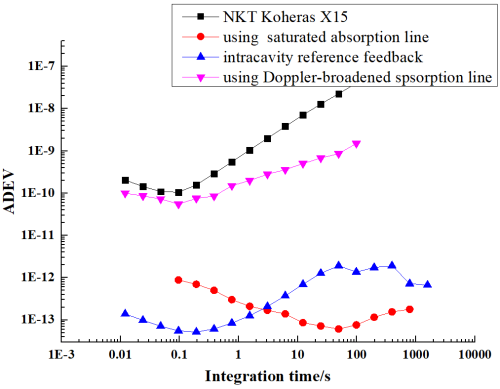A research team from Key Laboratory of Space Laser Communication and Detection Technology from Shanghai Institute of Optics and Fine Mechanics of the Chinese Academy of Sciences (CAS) has made research progress in the laser wavelength stabilization of single frequency fiber laser. The results were published in IEEE Journal of Lightwave Technology on Feb. 8, 2022.
Based on the intracavity frequency reference mechanism, the laser wavelength drift of fiber laser has been reduced successfully and this report could have particularly important significance for the transition of the highest precision optical metrology used in applications including atomic clocks, spectroscopy, LIDAR, and others, from the laboratory to the field, with reduced complexity and good robustness.
With the ability to laser interferometry or atomic spectroscopy at the highest levels of precision, an ultra-stable single frequency laser source is demanded in the most advanced optical metrology scientific experiments, including gravity-wave detection, optical clock, high-resolution spectroscopy, quantum sensing, and ultraprecise time and frequency transfer. In most instances, elaborate laser wavelength stabilization techniques are used to fulfill these needs through optical or electrical feedback from an external frequency reference, which benefit from high optical Q factors, such as Fabry–Perot cavities, absorption lines, and long-delay-line interferometers. However, with the increasing interest in making these scientific systems portable and applying them outside of the laboratory, it is still a challenge to realize a laser source that can reach the high wavelength stabilization and remain sufficiently compact and portable for field use.
Researchers have developed a wavelength stabilization fiber laser with an intracavity reference mechanism, by utilizing the beat note of dual modes inside the laser cavity as the laser wavelength drifts reference signal. A laser wavelength drift less than 5 kHz and ADEV 10-13 level at integration time scales from 0.01s to 1000s is achieved, which is to date the best results for the laser wavelength stabilization without the external frequency reference. The outcome of this work presents a clear novel way to achieve a stable laser source as an alternative to the laser locked to an absorption line or optical cavity design, with a simpler, lower cost feature. These advances all serve to highlight the promise of this wavelength stabilization fiber laser as the laser source for a growing body of portable applications from the highest precision optical metrology scientific experiment including atomic clocks, spectroscopy to the industrial areas including LIDAR and others, which require high wavelength stabilization, reduced complexity, and good robustness.

Fig. 1 The different level of laser wavelength drift in different conditions. (Image by SIOM)
Article website:
https://doi.org/10.1109/JLT.2022.3149747
Contact:
WU Xiufeng
General Administrative Office
Shanghai Institute of Optics and Fine Mechanics, CAS
Email: xfwu@siom.ac.cn
Web: http://english.siom.cas.cn/